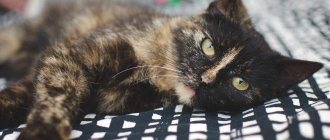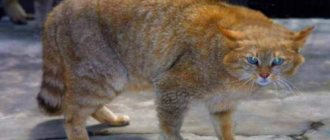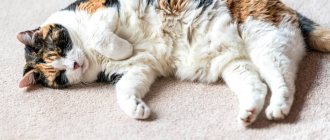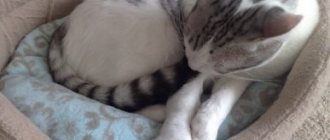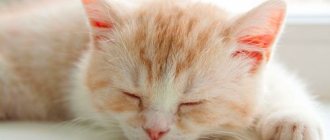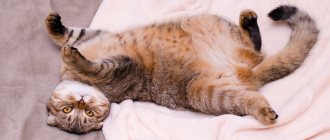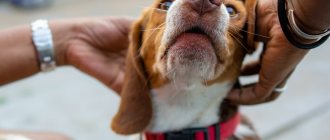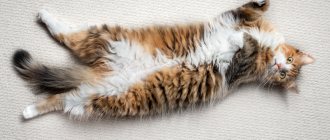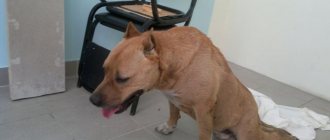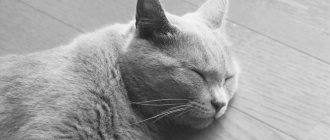If a cat has a bald belly, paws or withers, this may indicate a pathology. Only a veterinarian can find out the true cause; more details in the article.
The process of hair loss in both humans and animals is called alopecia . Hair loss in a cat can be accompanied by dermatitis and wounds, but it can also be asymptomatic. First you need to determine the cause of alopecia.
Read another interesting article on our website on the topic: “Behavior of Domestic Cats” . You will learn how to understand what your cat is trying to tell you.
From this article you will learn why it happens that cats go bald. You will also know how to diagnose and how to treat an animal with similar problems. Read on.
Why the cat’s stomach and hind legs are bald: reasons
The cat's belly and hind legs are bald.
Any process of changing a cat's fur is called molting. It can be physiological or pathological. The fur on a cat's back is always thicker than on its belly. Therefore, when you lose hair, your belly will be exposed first. The cat adapts to life in a house or apartment. Typically, seasonal shedding does not occur, as in wild cats; the coat changes gradually.
So, why does the cat's stomach and hind legs become bald? The intensity of hair loss may increase for the following reasons:
- Juvenile molt . Can be observed in kittens older than 5 months . Lasts 3 months . Children's wool is replaced with new ones.
- Pregnancy and lactation . During the production of hormones, the hair on the belly falls out. Since newborn kittens suffer from a lack of warmth, it is necessary for the mother to warm them with her bare belly. And for feeding, it is also desirable that there is no hair around.
- Old age . The state of the body of older animals changes at the hormonal level. Chronic diseases appear, which often lead to the disappearance of the coat.
Standard shedding is not a serious problem. This is normal, especially if it is seasonal (spring or autumn). The cat simply changes in appearance when the temperature changes. However, if molting is accompanied by a deterioration in the cat’s well-being, a decrease in its activity and health problems appear, you need to contact a veterinarian.
How to eliminate bald spots
When the answer to the question of why the cat’s belly is bald is known, you can proceed to the choice of therapy to eliminate the root cause of alopecia and restore the coat.
- In case of food allergies and lack of vitamins, it is enough to switch to anti-allergenic food and, if necessary, give additional vitamins.
- For treatment, the doctor will select a suitable hormonal drug. After therapy, the pet's coat should be restored.
- If fungal diseases are detected, special ointments and creams are prescribed that destroy pathogens.
In order to prevent the development of severe pathologies, it is necessary to promptly seek help from a veterinarian, even with such a minor symptom as abdominal baldness in a pet.
Source
Pathological causes of hair loss in cats: what's the matter?
The cat's belly and hind legs are bald.
The cause of pathological hair loss on the belly can be a number of factors. What's the matter in this case? Here are the pathological causes of hair loss in cats:
- Unbalanced diet
If you choose economy-class food or regular products, your cat may not have enough “building material” to form a coat. The reason is not only a lack of vitamins, but also their overdose.
- lice eaters
These are parasites that feed on wool.
- Helminths
Worms, worms that secrete endotoxins. The latter affect the hair follicles and also prevent vitamins in the gastrointestinal tract from being absorbed into the body. Signs of worms include diarrhea, vomiting, refusal to eat, etc.
- Stress
Moving, exhibitions, fright and the appearance of a new animal in an apartment or house, or in a cat’s body, often cause hair loss.
- Physical factors
If the house is hot and the humidity level is insufficient, failures in the animal’s thermoregulation occur. It saves itself from overheating by shedding excess “clothing”.
- Chemical factors
With frequent bathing, hair may also fall out, since detergents destroy the sutured hair membrane.
- Hormonal imbalances
Their causes are malfunctions of the thyroid gland, adrenal glands and uncontrolled use of steroid drugs.
- Chronic intoxication
Appears if your pet eats food that is infected with a fungus or contains toxic substances. The poison is removed from the body not only through diarrhea and vomiting, but also along with the hair.
- Allergy
An allergy can be to individual components in food, household chemicals, cosmetics, parasite repellents, and the hair of other animals. The cat begins to itch and licks the places where the rash and itching appear. Due to diligent licking, hairs may disappear.
- Fleas
Parasites often change the pet’s behavior - the cat begins to itch sharply. Itching can bother a cat even at night. The animal bites off whole pieces of fur, and the places it scratches become covered with crusts. Wounds are often accompanied by infections (pus is formed). With a large flea population, the cat’s general condition worsens - he loses weight, becomes restless and angry. Even people can suffer from fleas - the parasites bite their feet.
- Ticks
When a pet is infested with ticks, bald spots may appear on the face (in the ear area) and on the front legs. Baldness is located symmetrically. It is accompanied by severe itching. Wounds often fester. Skin mites in cats are microscopic and appear in those who suffer from weak immunity. Areas of bare skin turn red and become covered with dry scales.
- Lichen
This fungus is also dangerous for humans. Ringworm appears as round lesions with chopped off hair. The skin turns red and becomes covered with scales, and the cat constantly scratches the affected areas. Over time, the lesion increases in size.
- Adenitis
It is an inflammation of the sebaceous glands. Usually due to genetic predisposition. Adenitis most often affects kittens and older animals. Bald spots are round. They form in the ears, neck and head. The disease is accompanied by an unpleasant odor. The skin becomes yellow or gray and clammy. Adenitis and eczema should not be confused.
- Folliculitis
An infection that affects the hair follicles. It causes hair to become brittle. Inflamed blisters form on the face and neck. The cat is suffering from itching. The reason is allergies or weak immunity.
- Alopecia areata
There are two types:
- Autoimmune - represents the periodic appearance of bald spots. The fur is gradually recovering. The cat does not suffer from itching.
- Symmetrical – when baldness appears in the groin, stomach and thighs. It is much less common.
If such symptoms appear, you and your cat should consult a veterinarian.
- Seborrhea
It can be congenital or acquired. The affected areas are covered with small scales. Dandruff appears on your pet's fur and gives off an unpleasant odor.
- Hypothyroidism
Genetic pathology can cause complete hair loss in childhood. Newborn kittens have sparse fur. At 3-4 months, kittens become completely bald. Be careful, because without fur, a kitten can freeze in winter or overheat in summer. Pay attention to your cat's drinking regime in the summer and keep him warm in the winter.
- Hyperthyroidism
Malfunctions of the thyroid gland and an increased amount of hormones lead to seborrhea. The cat constantly licks itself, and with simple stroking, its fur will easily fall out. This reaction can be caused by any hormonal disorder:
- Adrenal diseases
- Malfunctions of the pancreas
- Problems with the ovaries or testes
Regular use of hormonal medications also often causes strong hormone production. The cat drinks a lot of water, goes to the toilet often, and its abdominal cavity increases in size.
- Oncological diseases
When a tumor forms, the hair completely falls out in the lower part of the body. Gradually, bald spots spread to the chest and paws. At the end of the disease, the cat loses most of its hair.
Principles of treatment
When starting to treat allergies, it is necessary to identify the allergen.
Reactions to flea and other insect bites can be eliminated by local treatment of the skin and hair with insecticidal agents. Particularly popular are drops on the withers - Bars, Barrier-super, Frontline.
Food allergies are eliminated by eliminating hazardous foods from the diet and prescribing antihistamines. Dust – creating conditions for a comfortable living of the animal: regular wet cleaning of the premises, cleanliness of the habitat.
Atopic dermatitis, due to the genetic nature of the disease and its chronic long-term course, is treated throughout life using maintenance therapy and the prevention of secondary pathologies.
The most common disease of the pancreas is pancreatitis. Since baldness can occur only with severe pancreatitis, treatment consists of intensive care, namely:
- elimination of pain – antispasmodics, painkillers, anesthetics, analgesics;
- combating dehydration - saline, colloidal solutions, droppers, injections;
- reduction in the production of destructive secretions - atropine and analogues;
- relieving edema and slowing down pancreatic functions - hormones, ribonuclease;
- removal of intoxication;
- severe case - surgical intervention.
Following a diet containing foods that have enveloping properties is mandatory.
Pyoderma and bald spots.
Help for pyoderma consists of a complex of therapeutic measures: local treatment, oral medication, injections, herbal medicine. For local treatment, anti-inflammatory gels, tinctures, streptocidal ointment, Cefakure, Maxidin are prescribed.
Antibiotics – Tylozolin, Lincomycin hydrochloride, Clindomycin, Cephalexin, Erythromycin. Gamma globulins, Staphylococcal anatoxin, Evinton, Neoferon, Bactoneotim. Healing drugs – Gamavit, Katazol.
Herbal medicine – chamomile, celandine, calendula, sage, eucalyptus.
Hyperthyroidism
The goal of treatment for hyperthyroidism is to reduce the level of thyroid hormones in the blood.
There are two main treatment methods available: drug support throughout the entire life cycle and surgical removal of the gland. Long-term use of medications that inhibit the production of thyroid hormones containing thiourea is indicated. Medicines that support the functioning of the heart and the entire vascular system. Medicines that support kidney function.
Treatment of hypothyroidism comes down, first of all, to replenishing the deficiency of the hormone that led to the disease. The main drug prescribed for pathology is Levothyroxine sodium. The dose is selected individually for each animal, depending on the existing deficiency and body weight. The course for complete recovery is designed for four weeks of use. At the same time, we can take drugs that slow down the binding of serum proteins - glucocorticoids, salicylates.
How to diagnose at home and in a veterinary clinic if your cat has a receding hairline?
If a cat has a receding hairline, then it is better to carry out the diagnosis in a veterinary clinic.
Since there are many causes of baldness, only a specialist can determine the true cause of hair loss. How to diagnose in a veterinary clinic if a cat has a receding hairline? Typically, a number of activities are carried out to help establish the diagnosis:
- Collecting information about the cat’s way of life and its diseases.
- Examination of the pet.
- General blood analysis. If necessary, a biochemical test may be prescribed.
- Microscopic examination of hair.
- Scrapings from the affected area of skin. This will help identify diseases that are caused by the fungus.
- X-ray and ultrasound.
It is quite difficult to determine the cause of baldness at home, but you can pay attention to the cat’s behavior:
- If baldness is accompanied by vomiting and diarrhea, there is a high probability that it is caused by worms or poisoning.
- If your cat is itching in the damaged area, this may be due to parasites or an allergic reaction. When a cat has allergies, tears usually flow from their eyes.
- Perhaps the cat's behavior has changed. Now at the slightest noise he hides under the sofa. Stress may be the cause.
- Try changing food. If after this the hairline begins to recover, the reason is in the diet.
- Check the ears and the animal. Black discharge in the ears may indicate a mite.
- If your cat reaches for the fan or tries to spend more time in the bathroom, the reason may be high temperature or insufficient humidity in the room.
Important : If there are other animals in the house, isolate them from the sick cat.
Baldness treatment
Depending on the root cause of the baldness of the cat’s paws, an appropriate therapeutic regimen is selected.
- In case of vitamin deficiencies, it is necessary to adjust the diet and add special vitamin and mineral complexes to the diet of a cat who is severely balding.
- In case of allergies, it is enough to eliminate the foreign protein and the pet’s fur will become shiny and thick again.
- If the cause of baldness of the paws is ectoparasites, then it is necessary to get rid of them with the help of special veterinary drugs and the cat’s coat will be restored.
- When a cat goes bald due to endocrine disorders, treatment consists of prescribing hormonal medications to the pet.
- For liver pathologies, maintenance therapy is prescribed, which will eliminate intoxication of the body, help the liver cope with its functions, and also prevent the progression of the pathology and the development of secondary diseases.
When a cat becomes bald on its stomach near its paws, it is very important to correctly diagnose and choose treatment. Otherwise, the animal’s condition may worsen and, in addition to baldness, there will be loss of appetite, depression, impaired coordination, vision, and convulsions.
The cat's stomach, hind legs, and withers are bald: what to do, how to treat it?
If a pet has health problems, it is always a worry for the owners. After all, you want to help the animal as quickly as possible. So, the cat has a bald stomach, hind legs, and withers - what to do, how to treat it? First you need to determine the cause of the disease and eliminate it:
- Check your cat's diet . Choose hypoallergenic quality food. With the right diet, you don’t even have to look for additional sources of vitamins.
- Improve the animal's living conditions . Move his bed away from the radiator and humidify the air.
- Use parasite killers . For example, Spot-on or IN-AP .
- If you are sure that the cause is an allergic reaction , tell your veterinarian.
- If the cause is stress , use sedatives, for example, Stop-Stress or Vetspokoin .
There are special vitamins for cats against hair loss. For example, brewer's yeast helps a lot. But you should not self-medicate. Be sure to visit a veterinarian. Only he will be able to establish an accurate diagnosis and choose a method of treating the animal.
Baldness treatment
Depending on the root cause of the baldness of the cat’s paws, an appropriate therapeutic regimen is selected.
- In case of vitamin deficiencies, it is necessary to adjust the diet and add special vitamin and mineral complexes to the diet of a cat who is severely balding.
- In case of allergies, it is enough to eliminate the foreign protein and the pet’s fur will become shiny and thick again.
- If the cause of baldness of the paws is ectoparasites, then it is necessary to get rid of them with the help of special veterinary drugs and the cat’s coat will be restored.
- When a cat goes bald due to endocrine disorders, treatment consists of prescribing hormonal medications to the pet.
- For liver pathologies, maintenance therapy is prescribed, which will eliminate intoxication of the body, help the liver cope with its functions, and also prevent the progression of the pathology and the development of secondary diseases.
When a cat becomes bald on its stomach near its paws, it is very important to correctly diagnose and choose treatment. Otherwise, the animal’s condition may worsen and, in addition to baldness, there will be loss of appetite, depression, impaired coordination, vision, and convulsions.
Prevention to prevent your cat from going bald
A flea and tick collar is a preventive measure to prevent your cat from going bald.
Hair loss is one of the symptoms of a deviation in the health of an animal’s body. There are preventive measures that will help the animal be healthy. So, in order for the pet to be healthy, the cat does not go bald, but is always beautiful and in a good mood, follow the following rules:
- Choose quality food . When choosing, consider the age and condition of the animal. For example, there is food for pregnant cats, kittens or cats suffering from certain diseases (therapeutic).
- Take antihelminthic courses every 3 months.
- Use flea collars. Also regularly treat cats with special drops against parasites (drip on the withers).
- Eliminate anything that may cause allergies.
- Be sure to vaccinate your animal.
- Brush and wash your cat regularly.
By paying close attention to your pet, serious illnesses can be avoided. Please note that some diseases that are accompanied by hair loss in a cat can also pose a danger to humans (for example, lichen or intestinal parasites). Therefore, be attentive to the health of your pet and if any ailments appear, consult a veterinarian. Good luck!
How to eliminate bald spots
When the answer to the question of why the cat’s belly is bald is known, you can proceed to the choice of therapy to eliminate the root cause of alopecia and restore the coat.
- In case of food allergies and lack of vitamins, it is enough to switch to anti-allergenic food and, if necessary, give additional vitamins.
- For treatment, the doctor will select a suitable hormonal drug. After therapy, the pet's coat should be restored.
- If fungal diseases are detected, special ointments and creams are prescribed that destroy pathogens.
In order to prevent the development of severe pathologies, it is necessary to promptly seek help from a veterinarian, even with such a minor symptom as abdominal baldness in a pet.
Source
Diagnostics
It's not always easy to understand why a cat suddenly started going bald. Usually the exact cause of the pathology is established by excluding all possible causes for baldness.
It is worth carefully examining the animal, paying special attention to the abdomen, hind and front legs. It is necessary to assess the condition of hairs in the coat
Also estimate how large an area is affected by the patch of baldness. Is there a border to the bald area, or has the animal’s coat simply thinned out? It is necessary to exclude infectious and fungal infections of the skin.
A fairly common reason for a cat going bald on its legs or belly is fleas. If an animal unprotected from parasites walked on the street, then it could easily pick up fleas. Their bites often cause the cat's belly, back and legs to go bald. If fleas are found in an animal's fur, it is necessary to immediately treat it with special preparations.
If all the most likely causes have already been considered, but none of them are suitable, then it is best to contact a veterinarian for a diagnosis.
How to eliminate bald spots
When the answer to the question of why the cat’s belly is bald is known, you can proceed to the choice of therapy to eliminate the root cause of alopecia and restore the coat.
- In case of food allergies and lack of vitamins, it is enough to switch to anti-allergenic food and, if necessary, give additional vitamins.
- For treatment, the doctor will select a suitable hormonal drug. After therapy, the pet's coat should be restored.
- If fungal diseases are detected, special ointments and creams are prescribed that destroy pathogens.
In order to prevent the development of severe pathologies, it is necessary to promptly seek help from a veterinarian, even with such a minor symptom as abdominal baldness in a pet.
Source
